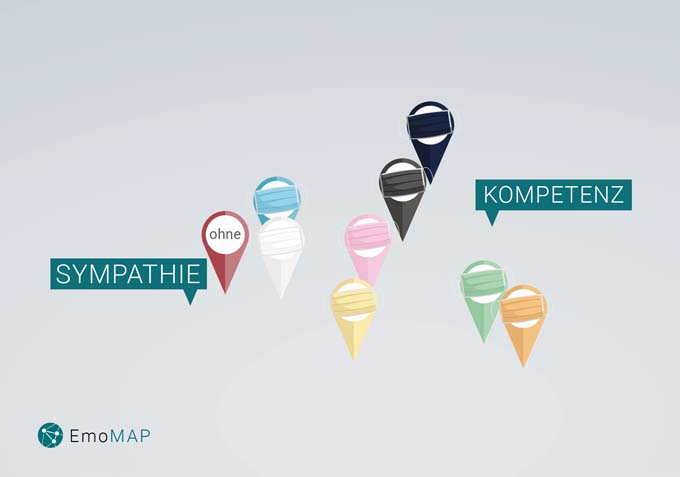Which mask color helps to create the best consulting experience?
The pandemic has made protective masks the norm in customer consultations. In the large selection of color variants, the question arises: Which mask color is best for consultations?

In Switzerland, up to 3.5 million masks are used every day. As a result of the pandemic, protective masks have also found their way into the everyday life of customer consultants - sooner or later, perhaps even soon, the obligation to wear them will be dropped. Irrespective of this: because colors are known to be psychologically very influential, consultants from a wide range of industries are now considering not only which shirt or blouse color they should wear - but also which mask color.
What makes an optimal consultation
The question of which mask color is best for the consultation must be answered in connection with another core question: What constitutes optimal consulting in the first place? Scientific studies have already shown in the past that trust is the key factor for an optimal relationship between advisor and customer. This trust, in turn, is based on the two consultant characteristics "sympathy" and "competence. In psychological experiments, sympathy turned out to be the more important factor. Customers trust a sympathetic advisor more than a competent one. The best-case scenario is, of course, achieved when a consultant appears likeable and competent at the same time (cf. Competence-Likability-Model by Tiziana Casciaro and Miguel Sousa Lobo). The optimal mask color should therefore pay attention to both characteristics and make the consultant both more likeable and more competent.

The neuromarketing consultancy Zutt & Partner has studied the emotional impact of different mask colors in an EmoCompass®-study and compared with the two characteristics "sympathy" and "competence". The emotional effect of the different mask colors was elicited completely non-verbally and monadically, i.e. not by simply assigning the colors to the two poles. This methodology allows the exploration of the emotions on a deep individual association level and practically under exclusion of cognition. The result shows which protective masks customer advisors should wear - and which they should better steer clear of.
It is not because of the mask color
The study results make it clear that sympathy and competence are emotionally two very different worlds. They are clearly distinct from one another and form two opposite poles. The mask colors can be placed between these two poles. The closer a mask is to one of the two poles, the more similar the emotional effect.
What is probably not entirely surprising is that masks - regardless of their color - always make customer advisors at least a little less likeable. Covering half the face and thus also a friendly smile has been proven to reduce a person's likability.
From a marketing perspective, however, masks also have an advantage. For example, the masked consultant automatically appears more competent - regardless of the color of the mask. One reason for this could be the association with medicine. Thus, the customer's brain associates masks with competent doctors and surgeons. In addition, the customer is not distracted, or is less distracted, by facial expressions, sympathy and antipathy, so that the focus is again more on the content of the conversation and thus on the consulting competence.
The best mask colors for the best consultation
For optimal customer consulting, those masks stand out that are emotionally as close as possible to sympathy and competence in the customer's brain. Since sympathy is the more important factor for successful consulting, the following masks are important. white and light blue masks the best choice. Although people without masks still look more sympathetic, white and light blue masks lose less sympathy than other mask colors.
The second best choice form dark blue and black masksbecause these increase the emotional competence effect of the consultant. A certain mask color comes to lie in the middle of the emotional map and thus triggers both sympathy and competence: Pink. But the emotional effect is too weak in this case. The consultant appears neither much more likeable nor more competent with a pink mask.
Clearly to be avoided are yellow, green and orange masks. Because these pull emotionally too strongly away from sympathy and competence. But since these two factors are decisive, the selected mask should at least pay attention to one of the two factors.
Conclusion of the study
The color choice of the protective mask has an influence on the consulting experience. The right mask can arouse emotions of sympathy and competence in the customer's brain and thus significantly influence the success of the consultation. In case of doubt, the sympathy factor should be given priority. Therefore, based on studies, the light blue and white masks are the best options for consultants.
But the perfect mask would be a combination of both worlds. Competence was mainly triggered by the darker masks, namely the dark blue and the black. Thus, the perfect mask would be a light blue or white with dark elements.
Source and further information: Zutt & Partner









